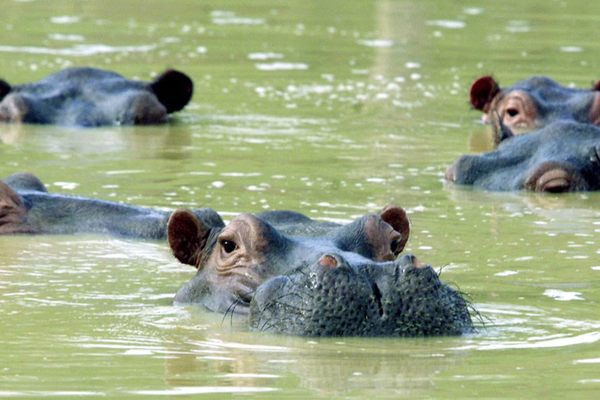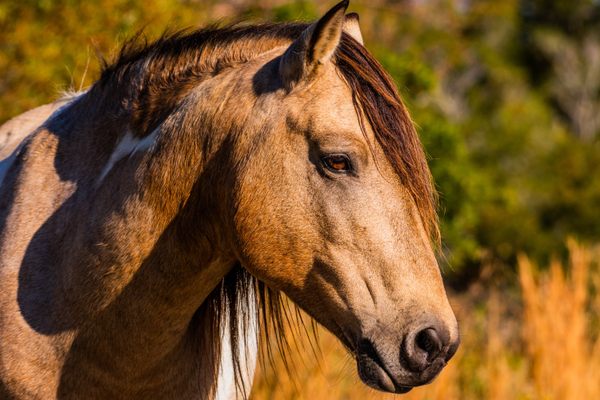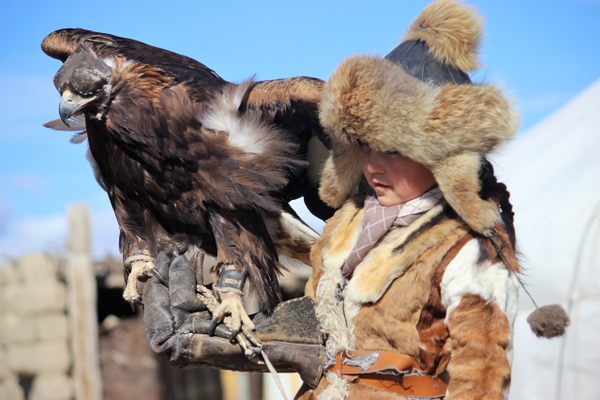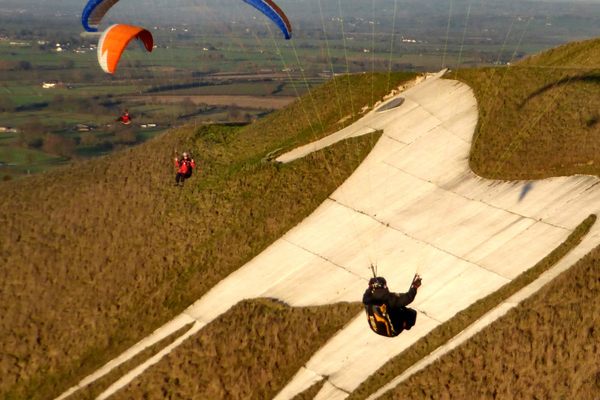
Remembering When Horse Diving Was an Actual Thing
For 50 years, this bizarre act was one of Atlantic City’s biggest attractions.
All the lights went out, except for the spotlight trained on the top of the platform. There, Powderface stood, seemingly unperturbed by the crowd below or the bathing suit-clad woman on his back, his coat glowing white against the darkness. For a moment, the horse paused and shifted his weight from hoof to hoof. Forty feet below was a pool of water, just 12 feet deep. The audience was rapt, the only sound coming from the waves crashing against the sides of Steel Pier, Atlantic City’s boardwalk that extends 1,000 feet off the New Jersey coast.
“I did not have the sense that he was afraid at all,” remembers Cynthia Branigan, author of The Last Diving Horse in America, who was among the spectators that day in August 1964. The future author and animal rights activist was 11 years old at the time. “It seemed to me that he was just taking it in, enjoying his moment in the spotlight.”
Suddenly, Powderface cantered off the edge. Both horse and rider seemed to hang in the air for an instant, then plummeted, and disappeared into the water with barely a ripple. The crowd erupted into furious cheers as Powderface surfaced and the woman slid from his back. As an attendant rushed to towel off his dripping flanks, the horse seemed to exude the casual arrogance of a star athlete.

“The whole thing lasted, I guess, 30 seconds, maybe 20 seconds, but that moment is seared into my consciousness,” Branigan says. “The lights went on and the crowd dispersed. And I started to cry a little bit. Not weeping and wailing, but tears rolled down my cheek. I was deeply affected by something, and I didn’t even know what. It was over, but really, it wasn’t over for me.”
As bizarre, even cruel, as it might seem today, horse-diving was a prime traveling attraction that found a steady home in Atlantic City. From the moment the first horses dove for crowds at the Steel Pier in 1928, the act was a sensation. For 50 years, horses and riders took the plunge there anywhere from two to six times a day, despite the obvious safety risks.
Broken bones and minor injuries were a regular occurrence for the riders—sometimes the injuries were more severe. (History doesn’t record any particular injuries to the horses.) Oscar Smith, a 19-year-old who took his first and last dive in San Antonio, Texas, in 1907, died when he hit the water. Sonora Webster Carver, who was later the subject of the 1991 film Wild Hearts Can’t Be Broken, lost her sight when her retina detached on impact in 1931. She continued to dive, blind, for another 11 years.

The man behind this spectacle was almost more outlandish than the act itself. William F. “Doc” Carver was a larger-than-life figure with a pathological flair for embellishment. “One of the first things about him was that he used to lie about his date of birth,” says Branigan. Although he claimed to have been born in 1840, her research places his birth at 1861. “He made up a story that his family was attacked by Indians, and he managed to escape and was raised by Indians. It was total fiction.”
“[Doc Carver] was a very flamboyant kind of Wild West character,” she adds. The nickname “Doc” came from a stint as a dentist, though maybe not a real dentist. For years, he worked as a hired buffalo hunter, when the U.S. government slaughtered tens of millions of bison (with the idea that this would help bring Native Americans under control).
Carver got so good with a gun, in fact, that he was one of the country’s foremost competitive sharpshooters. “They would release birds and he would shoot them out of the sky, then they changed it to glass balls filled with feathers, and they would throw them up in the air and he would just hit every one, always,” Branigan says.
His marksmanship, combined with innate bravado, led him to join forces with Buffalo Bill Cody. The two teamed up for Buffalo Bill’s Wild West Shows, a vaudevillian act with live bison and costumed cowboys and Native Americans shooting blanks at one another. “That didn’t last that long, because two competing egos, Buffalo Bill and Doc Carver, are never going to work,” Branigan says.

Carver attempted his own Wild West show, leading to a bitter, lasting enmity between the two men. For a time, he struggled to find a niche in entertainment—until he stumbled upon the idea of having a horse jump off a high dive into a shallow pool. How precisely that happened, like so many things with Carver, is a matter of speculation.
“Doc told two versions, but I think it was actually based on something else entirely,” Branigan says. “One version was there were Indians chasing him and he got to the edge of the Platte River in Nebraska and had nowhere to go. So he and his horse dove into the river and the two of them swam to the opposite shore. Another version was the old, ‘It was a dark and stormy night,’ and he was out with his horse and a bridge collapsed and they went into the river and swam to the other side.”
Both stories circulate today, but Branigan has another theory. In 1891, on tour in Australia, Carver was involved with another Wild West–themed show called The Scout. At one point, the bridge that the horses were on was pulled down, so the horses tumbled into the tank of water below. “I think that gave Doc the idea that as a lone act without any story around it, just the visual of a horse going into water, would be sufficient,” Branigan says.
Back on American soil in 1894, Carver attempted to recreate that magic in St. Louis, Missouri, with a sleek, compact mare named Black Bess. “People couldn’t get enough,” Branigan says. “But he always felt as if maybe there needed to be more. It was good, but he wanted it to be better. And he came up with the idea of having a woman on the horse’s back.”
It was a brilliant stroke of showmanship, if not workplace safety. A pretty, smiling woman turned an animal trick into a circus-worthy act. The first young woman to try this was known as Lorena Lawrence. As with most elements of Carver’s story, some of the details are suspect. At some point, Lorena Lawrence became Lorena Carver, and claimed to be Doc’s daughter. “But then later she became his daughter-in-law because she married someone named Al Floyd, who, after Doc died, took the last name of Carver. So she never married his son. He didn’t have a son,” Branigan says. “I doubt Lorena was even her real name.”
Whoever she was, she was an immediate sensation. “Lorena appeared in 1906 on the back of a horse and then, literally, the crowd went wild,” Branigan says. “Doc expanded his empire. At one point, he had six horses, three of them east of the Mississippi and three of them west of the Mississippi.”

Shortly after Carver himself passed away in 1927, his over-the-top act found a perfect venue in Atlantic City’s Steel Pier. When the “City on the Sea,” as it was sometimes called, first opened to the public on June 18, 1898, it was considered an architectural jewel. More than 40,000 visitors wandered up and down the boardwalk on a daily basis. Daredevil performances fit right into the ethos. After all, Annie Oakley, a Wild West character to equal Buffalo Bill, performed a few sharpshooting tricks on the inaugural day.
Business was good for decades, but by the 1970s, the crowds were starting to dry up. Carver had died and the world had moved on. In 1978, Resorts International purchased the Steel Pier and decided to do away with the washed-up act. By then, management viewed the spectacle as something of an embarrassment—not to mention a distraction from the slot machines.
“When I saw it in 1964, it was shoulder-to-shoulder with people,” Branigan says. “But when the Piers bought it in ‘78, nobody was there, really. The people who worked at the Pier were the only ones watching Powderface dive.”
Powderface, like many of the other diving horses, met his end when those in charge of the show had no more use for them. After Resorts Casino took over, the remaining diving horses were sent to auction and sold to the highest bidder. “If you think horse diving is bad, it’s nothing compared to what happened to them afterwards,” Branigan says. “Absolutely unconscionable. I’m, to this day, furious that the city of Atlantic City would have allowed that to happen.”

By that time, Branigan was involved with the Fund for Animals. In 1980, she received a phone call at the office about the last of the diving horses from Atlantic City. When she found out that Powderface, the same horse seared into her formative memories, had been sent to the slaughterhouse, she knew she had to do something.
“I felt a lump in my throat,” she remembers. “And even though I wasn’t in charge, technically, I told the woman, don’t worry, we’ll get the other one. We did. That other one was Gamal, [whom I was able to] keep for the rest of the horse’s life.”
By that time, Gamal, a dark bay with a star on his forehead, was 26 years old. The Steel Pier had sold him to a summer camp, which sent him to the auction block thinking they might make an extra buck off the “last diving horse.” Branigan paid $2,600—far more than any of the other bidders even considered. Most horses toward the end of their natural life were valued by the pound, meaning Gamal would have gone for no more than $500.

“I think they were all laughing at me thinking I was really taken, but I wasn’t, of course,” Branigan says. “He was worth every penny. I was betting against myself at some point. I just kept raising the paddle wildly because I knew I had to get him no matter what.”
The last diving horse lived out the rest of his life in relative tranquility. To this day, Branigan describes having a remarkable bond with this animal who had lived through so much. “He wasn’t a long, leggy, elegant thoroughbred. He looked like a horse who could work,” she says. After so many years in show business, Gamal wasn’t exactly cuddly with humans. “He looked at me out of the corner of his eye. I likened him to maybe a carnival worker, the tough old guy with a cigar out of the corner of his mouth, wearing a vest, a T-shirt, and a derby hat.”
Gamal is likely to remain the last diving horse. In 1993, the Steel Pier attempted to revive the act with mules standing in for horses, but quickly ditched the act. In 2012, the idea of bringing back horse-diving was briefly floated around, until the Steel Pier’s owner, Anthony Catanoso, dismissed it in light of protests by activists.
No one seemed disappointed. As Wayne Pacelle, then president and chief executive of the Humane Society of the United States, told Reuters, “This is a merciful end to a colossally stupid idea.”



















Follow us on Twitter to get the latest on the world's hidden wonders.
Like us on Facebook to get the latest on the world's hidden wonders.
Follow us on Twitter Like us on Facebook